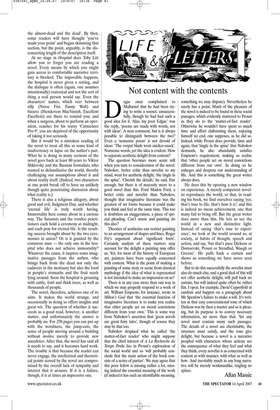Voodoo, rape and an apple tree
Simon Baker
HOSPITAL by Toby Litt Hamish Hamilton, £14.99, pp. 510, ISBN 9780241142806 ✆ £12.75 (plus £2.45 p&p) 0870 429 6655 Asummary of the events that take place in this novel might run as follows: a lost boy (who may be the soul of a comatose adult) walks around a hospital with an apple tree growing inconveniently in his stomach. He explores most of the floors, some of which are in a different dimension, and meets, among others, the kinky ‘Rubber Nurse’. Elsewhere, Nurse Swallow loves Mr Steele, a handsome surgeon. Nikki Froth, a prostitute, is hiding from her drug-addled pimps, Spanner and Case. PC Dixon loves Nikki. Sir Reginald SaintHellier, the head surgeon, leads a Satanist cult which murders babies and rapes virgins on the building’s 13th floor. Haitian porters perform voodoo rituals. Half way through the novel, the world outside the hospital disappears, those inside become immortal and the dead resurrect.
Having once spent the small hours in St George’s Hospital, Tooting, I found some of this a good deal more familiar than the author probably intended. Overall, though, Hospital is a work which deliberately refuses to draw the reader into a recognisable fictional setting. It is a 500-page novel with no plot (just lots of strands and episodes), no characters (just dozens of grotesques) and, on one view, no purpose other than to act as a huge canvas for many disparate aperçus, some of which are brilliant, others not. In places the writing is intentionally hopeless: ‘He was gorgeous and efficient, a surgical whizz and the most handsome man she’d ever seen’. Elsewhere it is monumentally long-winded; a description of the A&E unit begins: ‘Here came twisted ankles, dog bites, sprained wrists’ and ends 50 lines later: ‘Here came the dying and the almost-dead and the dead’. By then, some readers will have thought ‘you’ve made your point’ and begun skimming that section, but the point, arguably, is the disconcerting length of the description itself.
At no stage in Hospital does Toby Litt allow you to forget you are reading a novel. Every means by which you might gain access to comfortable narrative territory is blocked. The impossible happens, the hospital is never given a setting, and the dialogue is often (again, one assumes intentionally) oratorical and not the sort of thing a real person would say. Even the characters’ names, which veer between silly (Nurse Fist, Fanny Wall) and bizarre (Henderson MacVanish, Excellent Excellent) are there to remind you; and when a surgeon, about to perform an operation, reaches for his trusty ‘Cutmeister Pro-9’, you are deprived of the opportunity of taking it too seriously.
But it would be a mistaken reading of the novel to treat all this as some kind of inadvertency or lapse on the author’s part. What he is doing in many sections of the novel goes back at least 80 years to Viktor Shklovsky and the Russian formalists, who wanted to defamiliarise the world, thereby challenging our assumptions about it and about reality itself. (Indeed, two characters at one point break off to have an unlikely though quite penetrating discussion about what reality is.) There is also a religious allegory, about good and evil, Judgment Day, and whether ‘eternal life’ is truly worth having. Immortality here comes about in a curious way. The Satanists and the voodoo practitioners each hold a ceremony at midnight, and each pray for eternal life. Is the resulting success brought about by the two ceremonies in union? Or is it granted by the comatose man — the only one in the hospital who does not achieve immortality? Whatever the cause, it inspires some imaginative passages from the author, who brings back from the dead not only the cadavers in the mortuary but also the food in people’s stomachs and the fruit seeds lying around. Soon the hospital is groaning with cattle, fowl and thick trees, as well as thousands of people.
The novel, therefore, achieves one of its aims. It makes the world strange, and occasionally in doing so offers insights and great wit. The question of whether it succeeds as a good read, however, is another matter, and unfortunately the answer is probably no. For 250 pages you can put up with the wordiness, the jump-cuts, the sense of people moving around a building without motive merely to provide new anecdotes. After that, the novel has said all it needs to say, and it becomes hard work. The trouble is that because the reader can never engage, the intellectual and theoretical points scored by the novel are compromised by the overall lack of sympathy and interest that it arouses. If it is a failure, though, it is at times an impressive one.



































































 Previous page
Previous page